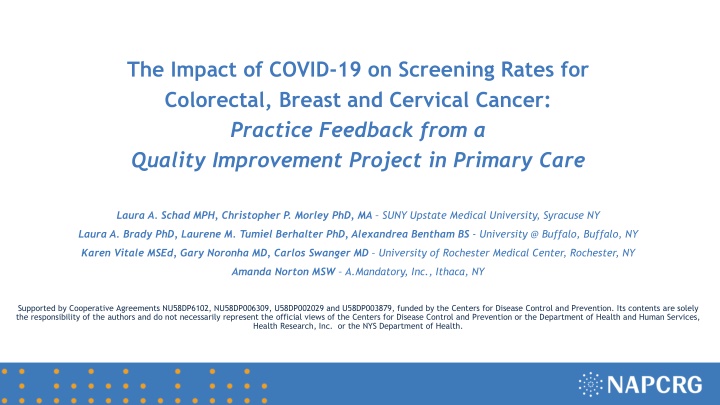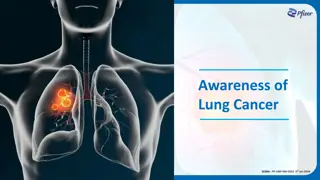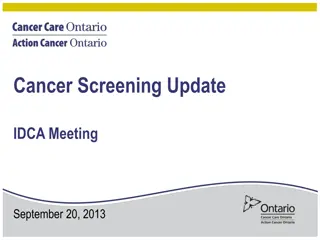Impact of COVID-19 on Cancer Screening Rates in Primary Care
This study examines the impact of the COVID-19 pandemic on colorectal, breast, and cervical cancer screening rates in safety-net primary care practices. A 7-year Quality Improvement Project aimed to increase screening rates through tailored education and practice facilitation. The project faced challenges during the pandemic, resulting in changes in in-person activities and staff limitations. Despite improvements in breast and colorectal cancer screenings in earlier years, the team expected a drop in all screening rates due to COVID-19. The research design involved longitudinal evaluation processes, pre/post comparisons, and qualitative interviews in Spring 2020. Responses were analyzed to assess the pandemic's impact on screening practices.
Download Presentation

Please find below an Image/Link to download the presentation.
The content on the website is provided AS IS for your information and personal use only. It may not be sold, licensed, or shared on other websites without obtaining consent from the author.If you encounter any issues during the download, it is possible that the publisher has removed the file from their server.
You are allowed to download the files provided on this website for personal or commercial use, subject to the condition that they are used lawfully. All files are the property of their respective owners.
The content on the website is provided AS IS for your information and personal use only. It may not be sold, licensed, or shared on other websites without obtaining consent from the author.
E N D
Presentation Transcript
The Impact of COVID-19 on Screening Rates for Colorectal, Breast and Cervical Cancer: Practice Feedback from a Quality Improvement Project in Primary Care Laura A. Schad MPH, Christopher P. Morley PhD, MA SUNY Upstate Medical University, Syracuse NY Laura A. Brady PhD, Laurene M. Tumiel Berhalter PhD, Alexandrea Bentham BS - University @ Buffalo, Buffalo, NY Karen Vitale MSEd, Gary Noronha MD, Carlos Swanger MD University of Rochester Medical Center, Rochester, NY Amanda Norton MSW A.Mandatory, Inc., Ithaca, NY Supported by Cooperative Agreements NU58DP6102, NU58DP006309, U58DP002029 and U58DP003879, funded by the Centers for Disease Control and Prevention. Its contents are solely the responsibility of the authors and do not necessarily represent the official views of the Centers for Disease Control and Prevention or the Department of Health and Human Services, Health Research, Inc. or the NYS Department of Health.
The Research Question Did the COVID-19 pandemic impact colorectal, breast & cervical cancer screening in safety-net primary care practices? 7-year Quality Improvement (QI) Project (2013-2020) aimed at increasing breast, cervical & colorectal (CRC) cancer screening rates through: Academic Detailing: tailored education on specific health topics to providers in their own setting One session Practice Facilitation: trained professionals assist practices in QI 6 months/year Participants: Safety-net primary care practices (PCPs) involved with practice-based research networks (PBRNs) in Central & Western New York State Year 7: Spring 2020 COVID-19 Pandemic; PCPs forced to stop/reduce in-person activities & furlough/limit staff onsite In early project years, breast and CRC improved; cervical was always a challenge We expected to see drop in all screening rates due to COVID-19 Team realized: It was important to note responses to the pandemic in real-time
Research Design and Method Longitudinal QI Project utilizing three regional PBRNs in upstate New York State Slate of evaluation processes each year Pre/Post Comparison of rates Qualitative interviews Spring 2020 (final project year) interviews included questions on impact of COVID-19 on screening Practice facilitators interviewed practice staff/stakeholders/key informants Coded without identifying information Responses from all practices assessed via content analysis Led by one team member, cross-validated by a second Initial themes discussed with broader team Second analytic, interpretive step Team included physicians, health service/public health researchers, practice improvement experts, social scientists Project determined to be QI (not research) by the Upstate Medical University IRB
What the Research Found Screening Rates did not sharply decline PCPs found ways to maintain rates Overarching Theme: Practices continued pre-COVID-19 processes New emphasis on Telemedicine many PCPs used what they knew, or developed new competency With fewer/no patient visits, PCPs focused on data clean up of records & registries, were able to identify & follow-up with patients in need of screening through telemedicine Many responses indicated shift of focus from preventive visits to care for sick patients CRC cancer: relatively unchanged by the pandemic Re-emphasis on at-home testing (e.g. FIT testing) PCPs were already mailing test kits to patients an existing strength PCPs had time to follow-up with patients who had a positive FIT kit before the pandemic Breast cancer: many PCPs use mobile mammography vans an existing strength Mobile screening units were repurposed for COVID-19 testing, a potential barrier; however Once the height of the pandemic settled, some regained access to mobile mammography Cervical cancer: hard to target/track pre-COVID-19 since many seek this at OB-GYN facilities OB-GYN clinics closed & fewer staff available to monitor patient data between sites
What this means for Clinical Practice Telemedicine was extremely useful for practices during this time Many PCPs used the time to improve telemedicine services BUT presented issues when patients did not have the means to access the technology May have continued practice revenue when in-person visits were not possible Takeaway: PCPs should develop telemedicine skills and capacity Some used the decrease in patient visits as time to improve Cleaning up patient records/data, filming screening tutorials Some have new appreciation for effective data management strategies Downtime used to better identify patients in need of screening Takeaway: data management processes helped maintain screening rates, which has been a consistent theme throughout our project; especially important during pandemic























